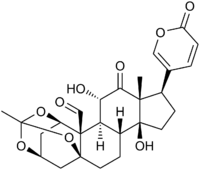- Daigremontianin
-
Daigremontianin  (1β,3β,5β,11α)-1,3,5-(ethylidynetris(oxy)-11,14-dihydroxy-12,19-dioxobufa-20,22-dienolide
(1β,3β,5β,11α)-1,3,5-(ethylidynetris(oxy)-11,14-dihydroxy-12,19-dioxobufa-20,22-dienolideIdentifiers CAS number 98205-50-6 PubChem 127105 ChemSpider 112839 
Jmol-3D images Image 1
Image 2- C[C@@]12[C@@](CC[C@@H]2C(C=C3)=COC3=O)(O)[C@]4([H])CC[C@]5(OC6(C)O7)C[C@@H]7C[C@@H](O6)[C@]5(C=O)[C@@]4([H])[C@H](O)C1=O
O=C\1O\C=C(/C=C/1)[C@@H]6[C@]5(C(=O)[C@@H](O)[C@@H]7[C@]3(C=O)C4(OC2(O[C@@H](CC3O2)C4)C)CC[C@H]7[C@@]5(O)CC6)C
- InChI=1S/C26H30O9/c1-22-15(13-3-4-18(28)32-11-13)6-8-26(22,31)16-5-7-24-10-14-9-17(34-23(2,33-14)35-24)25(24,12-27)19(16)20(29)21(22)30/h3-4,11-12,14-17,19-20,29,31H,5-10H2,1-2H3/t14-,15+,16+,17?,19+,20-,22-,23?,24?,25+,26-/m0/s1

Key: PHOLEJIIASOWOL-SQBSQXRJSA-N InChI=1/C26H30O9/c1-22-15(13-3-4-18(28)32-11-13)6-8-26(22,31)16-5-7-24-10-14-9-17(34-23(2,33-14)35-24)25(24,12-27)19(16)20(29)21(22)30/h3-4,11-12,14-17,19-20,29,31H,5-10H2,1-2H3/t14-,15+,16+,17?,19+,20-,22-,23?,24?,25+,26-/m0/s1
InChI=1/C26H30O9/c1-22-15(13-3-4-18(28)32-11-13)6-8-26(22,31)16-5-7-24-10-14-9-17(34-23(2,33-14)35-24)25(24,12-27)19(16)20(29)21(22)30/h3-4,11-12,14-17,19-20,29,31H,5-10H2,1-2H3/t14-,15+,16+,17?,19+,20-,22-,23?,24?,25+,26-/m0/s1
Key: PHOLEJIIASOWOL-SQBSQXRJBB
Properties Molecular formula C26H30O9 Molar mass 486.51 g mol−1  (verify) (what is:
(verify) (what is:  /
/ ?)
?)
Except where noted otherwise, data are given for materials in their standard state (at 25 °C, 100 kPa)Infobox references Daigremontianin is a bufadienolide. Bufadienolides are steroids and cardiac glycoside aglycones (meaning that they bind with carbohydrates to form cardiac glycosides) that are similar to cardenolides, differing only in the structure of the C-17 substituent on the D ring. This chemical has been found to be toxic in experiments on mice.[1][2] It is one of five bufadienolides that have been isolated from Kalanchoe daigremontiana.
Contents
Toxicity
Crassulaceans are one of the prime sources of bufadienolide cardiac glycosides (including daigremontianin) responsible for an estimated 33% of cattle mortalities related to plant poisoning in South Africa. Crassulacean bufadienolides cause cardiac poisoning, but repeated small doses cause a condition called cotyledonosis an intoxication affecting nervous and muscular systems of small animals, particularly, sheep in the Karoo area of South Africa.
Traditional medicine
In traditional medicine Kalanchoe species are used to treat several ailments, e.g. infections, rheumatism and inflammation. Kalanchoe sp. extracts have immonosuppressive effects. Two of the five Kalanchoe daigremontiana glycosides - daigremontianin and bersaldegenin 1,3,5-orthoacetate have shown to have sedative effect and with an increase in the dose an increasing effect on the central nervous system besides having strong positive inotropic effect associated with cardiac glycosides.
References
- ^ Wagner, Hildebert; Fischer, Manfred; Lotter, Hermann (1985). "New bufadienolides from Kalanchoe daigremontiana Hamet et Perr. (Crassulaceae)". Zeitschrift fuer Naturforschung, Teil B: Anorganische Chemie, Organische Chemie 40B (9): 1226–1227.
- ^ Wagner, Hildebert; Lotter, Hermann; Fischer, Manfred (1986). "The toxic and sedative bufadienolides of Kalanchoe daigremontiana Hamet et Perr". Helvetica Chimica Acta 69 (2): 359–367.
External links
Cardiac glycosides (C01A) Bufadienolides Proscillaridin • ScillirosideCardenolides DaigremontianinCategories:- Bufanolides
- Alcohols
- Aldehydes
- Ketones
- C[C@@]12[C@@](CC[C@@H]2C(C=C3)=COC3=O)(O)[C@]4([H])CC[C@]5(OC6(C)O7)C[C@@H]7C[C@@H](O6)[C@]5(C=O)[C@@]4([H])[C@H](O)C1=O
Wikimedia Foundation. 2010.
